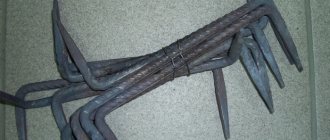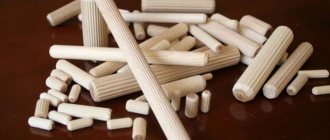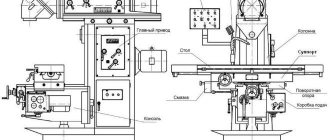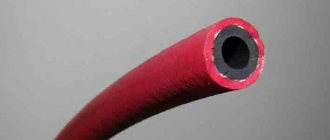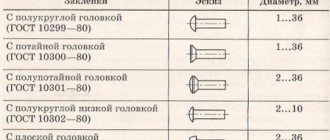Quick release couplings or breakaway couplings This is a mechanism that allows you to quickly connect two hydraulic units to each other or to high pressure hoses.
Breakaway couplings (quick-disconnect couplings) are used in road construction, oil or gas production, and are widely used in the chemical industry, as well as in various other industries. The use of quick-release connections does not require special skills and can be carried out by low-skilled personnel. The use of the coupling system does not require the use of any special tool.
Contrary to popular belief, quick-release couplings are not recommended for use as swivels (swivels) - rotation of quick-release couplings, especially under pressure, can lead to premature and very severe wear and leakage.
The basic design of breakaway couplings (BRC) is as follows:
1. socket (female)
2. nipple (male)
Quick release couplings (breakaway couplings) are made to different standards and from different materials, depending on where they will be used.
The following basic BRS standards are mainly used:
ISO-7241, ISO 16028 (Flat Face, FIRG or Flat End), Parker 3000 Series, Gromelle 6000 Series and many others.
Breakaway couplings (quick release couplings) are mainly made of carbon steel, aluminum, bronze or stainless steel, and, depending on the environment in which they are used, various types of sealing materials are used - NBR (nitrile butadiene rubber), Viton (FKM) , fluorine rubber), EPDM (ethylene propylene rubber).
Couplings and nipples, depending on the type of quick-release coupling, standard or series, can have different types of fastenings: internal thread, external thread, brush type fastening for a flexible hose, fastening for a plastic tube.
Markings on the Camlock body
Each camlock has a designation printed on its side surface.
If it says dc100 on the body, this means that the camlock part of the dc is a plug with levers that has a size of 1 inch, that is, 100 is the designation in inches.
Example of Camlock DC-100 markings
Let's see another one. d200 is written on the body - this means it is a camlock
- part d,
- size 2 inches,
- 2 inches is 51 millimeters.
Example of Camlock DC-200 markings
Device and dimensions
The quick release coupling consists of two main parts. The names of these parts are quite varied. However, it would be most correct to call them “coupling” and “nipple”. People also call them “mom and dad.”
A conventional coupling (“mother”) consists of the following structural elements:
- frame;
- a clamp for fixation, which consists of a locking sleeve and clamping balls;
- check valve;
- O-ring to seal the joint;
- connection adapter (separate or integrated).
Quick-release couplings may have other components, however, such products are less common than standard ones.
The nipple includes the following structural elements:
- frame;
- check valve;
- connection adapter (same as in the case of a coupling, can be separate or integrated);
- sealing element.
Fittings vary in design, diameter and purpose
Quick-release connections have a wide range of products that differ in length, diameter, weight, etc. The most popular are products with diameters from 12 to 150 mm. Many companies produce coupling systems for individual orders. The diameter of such products can reach up to 540 mm.
The characteristics of some types of coupling systems are presented in Table No. 1.
Table 1
| Du, mm | D1, mm | D2, mm | Length, mm | Weight, kg |
| 200 | 218 | 278 | 60 | 14,07 |
| 150 | 168 | 224 | 60 | 6,05 |
| 100 | 114 | 172 | 60 | 4,8 |
| 70 | 78 | 132 | 60 | 2 |
| 50 | 60 | 110 | 50 | 1,45 |
Pressure
The main characteristic of camlocks is working pressure. The working pressure of the connection depends both on its size and on the material from which it is made and varies in the range from 5 to 18 atmospheres. But there are camlocks with four levers; they are designed for higher pressure, that is, their working pressure is 20-40 atmospheres.
| Size | 1/2 “ | 3/4 – 2 “ | 2.1/2 “ | 3 “ | 4 “ | 5 “ | 6 “ | 8 “ | ||||||||
| Pressure | Bar | Psi | Bar | Psi | Bar | Psi | Bar | Psi | Bar | Psi | Bar | Psi | Bar | Psi | Bar | Psi |
| Brass | 11 | 150 | 18 | 250 | 11 | 150 | 9 | 125 | 7 | 100 | 5 | 75 | 5 | 75 | – | – |
| Bronze | – | – | 18 | 250 | 11 | 150 | 9 | 125 | 7 | 100 | – | – | – | – | – | – |
| Aluminum | 11 | 150 | 18 | 250 | 11 | 150 | 9 | 125 | 7 | 100 | 5 | 75 | 5 | 75 | 5 | 75 |
| Stainless steel | 11 | 150 | 18 | 250 | 16 | 225 | 14 | 200 | 7 | 100 | 7 | 100 | 7 | 100 | 3 | 50 |
The choice of material for the connection depends on the purpose where it will be used. If you work with water, then you can use camlocks made of aluminum; if you work with acids, alkalis or food media, then it is better to use stainless steel or polypropylene. If you work with oil-containing liquids or flammable liquids, it is better to use connectors made of brass and stainless steel.
Advantages and disadvantages of mechanisms
Like any product, quick-release couplings have a number of advantages and are not without their disadvantages. First, let's look at the advantages of these devices:
- wide choice and prevalence (quick connectors can be purchased almost everywhere);
- the budget nature of these products allows you to purchase them for domestic use;
- are able to provide a high level of joint tightness;
- due to its design, the couplings are easy to install and, if necessary, also easy to remove;
- Couplers are reusable products;
- do not lose their properties over a long service life.
The main disadvantages of such products include:
- if the consumer uses a combination of coupling gear parts from different manufacturers, the warranty will be removed from the product;
- 20% of such products are produced without interchangeable properties.
Seal
Also, when choosing camlocks, you should pay attention to the seal. The standard seal for quick-release couplings such as camlock is made of rubber, brand nr or mbr, but there are seals made of other materials: EPDM, silicone, fluoroplastic. That is, if you need to connect hoses through which some kind of chemical is carried, then you need to take either camlocks, firstly, from polypropylene or stainless steel, and most importantly, the seal should be at least made of fluoroplastic or silicone, that is, material that will hold chemicals.
Camlock seal
BRS type Bauer
We offer an economical system for quick-release connection of industrial hoses of the “Bauer” type
BRS BRS disassembled
O-ring for BRS Bauer
Bauer connections (parts and pipes) are used:
- in the mining industry for pumping water, mud
- in industry for the construction of roads and tunnels
- for drainage of groundwater or wastewater
- in cleaning systems
- for pumping water in drainage systems
- water supply and sewerage
- wastewater transfer
- transportation of granular and powder materials
- transportation of liquid and dry concrete and building mixtures
- in agriculture
- gardening
The use of Bauer-type systems is especially beneficial with a hose diameter of 200 mm.
System advantages:
- easy connection - with one hand,
- two-way connection at an angle of up to 15°,
- Complete tightness even with contaminated connections.
Bauer connections are made of galvanized steel.
Bauer-250
Camlock Standards
There are two standards of camlocks on the market, that is, mil standard quick connectors - American standard and din standard - European standard.
Most often the mil standard is used on the Russian market. The mil standard camlock has one seal on the connection itself, that is, one rubber seal.
The threads have to be sealed with either fum tape or sealant.
Mil standard camlock seal
For din standard camlocks, there are 2 seals on couplings with levers, parts a and d:
- one seal on the connection;
- the second seal goes on the thread.
It turns out that when working with din camlocks, you simply screw the camlock part A or part d into a pipe with an external thread. The seal occurs due to this gasket, which is located inside.
DIN camlock thread seal DIN camlock thread seal
Another difference between mil standard and din standard camlocks is in parts e and c. That is, if we take a mil standard camlock, it has a corrugated brush for the hose. Din standard camlocks have a smooth shank.
corrugated brush
smooth shank
We looked at standard camlocks - din standard, mil standard. There are also camlocks, curved at an angle, some with flanges, some with four levers, but this is a separate topic. They are not the most popular on the Russian market and are brought to order.
https://camlocki.ru/index.html
Types of connections
Based on the location and number of valves, all couplings are divided into three main groups:
- having free passage (not equipped with valves);
- the valve is located on one side;
- have valves on both sides.
Products for quick fixation of sleeves are equipped with a convenient snap mechanism. Installation of such couplings is easy and such connections reliably fix the tubes.
Today, the range of these products is incredibly wide, which allows you to choose the appropriate coupling system for a particular case. Today you can purchase several types of quick-release couplings:
- Quick couplings equipped with a locking wedge;
- cam devices (Camlock);
- products from European manufacturers (BAUER and Perrot);
- ISO connections, which include a conical valve.
Camlock type connection is considered the most effective and practical
Couplers are capable of joining flexible hoses or metal and plastic pipelines. Quick-release fittings for various pipelines can be made in various variations: couplings, tees, crosses, etc. This connection is made using a special clamping device - a collet.
Quick-disconnect (QRC) collet connections also allow for quick installation and dismantling of the pipeline structure. The main feature of this connection is that it allows the transition to thread.
Scope of use
Today, quick-release couplings have penetrated into many areas of human activity and are firmly entrenched there, thanks to their unique qualities and ease of use. Let's consider the main operational areas of the coupling system:
- Automotive industry;
- aviation industry;
- connection of pneumatic devices;
- defense sector;
- alternative sources of energy supply;
- shipbuilding;
- chemical industry;
- medical equipment;
- railway transport;
- polymer industry;
- mining industry;
- construction sector.
Quick-release connections are used in many areas, including in everyday life
Ferrari-type coupling system
The Ferrari system is a system of elastic connections. Used in gold mining and mining enterprises.
Such couplings do not require perfectly clean connections and special tools; everything is assembled by hand without the use of heavy equipment and hydraulic tools.
Temperature range: from -50°С to +110°С
Pressure: up to 13 bar.
Complies with standard: DIN 3459721
Ferrari-type quick-release coupling for a universal joint clamp (Male)
Possibility of angular deflection of connected elements (26° for small sizes, 20° for large sizes).
DN: 100, 120, 150, 200mm
Connection types: welded, clamped
Material: Galvanized steel
Quick-release universal joint for Ferrari-type clamp (Female)
DN: 100, 120, 150, 200mm
Connection types: welded, clamped
Material: Galvanized steel
Ferrari style quick coupling with groove (Male)
Thanks to the groove connection, smooth fixation is ensured
Connection type: External round thread 11/4
Material: Galvanized steel
Ferrari style quick release coupling with thread (Female)
Connection type: External round thread 11/4
Material: Galvanized steel
Ferrari style quick coupling with groove (Male)
DN: 50mm, 80mm
Connection types: threaded, welded, clamped
Material: Galvanized steel
Ferrari type quick release coupling (Female)
DN: 50mm, 80mm
Connection types: threaded, welded, clamped
Material: Galvanized steel
Ferrari type steel bend (Mom+Dad)
DN: 50, 80, 100, 120, 150, 200mm
Material: Galvanized steel
Ferrari type steel tee (Mother+Mom+Dad)
DN: 50, 80, 100, 120, 150, 200mm
Material : Galvanized steel
Ferrari type submersible filter
DN: 100, 120, 150, 200mm
Material: Galvanized steel
Filter hole: 30mm
Connection: Mom
Step-by-step instructions on how to use the parts
quick releases with automatic locking are becoming
increasingly , the installation of which is extremely simple and does not require any action with the sleeve.
It is enough to touch the components of the connection and apply light pressure.
If there is no automation, the installation process will look like this:
- The locking sleeve located on the coupling must be pressed in the direction of the adapter so that the clamp balls move.
- A nipple is inserted into the coupling.
- The bushing is gently released.
What's the catch?
Not everyone is assessed objectively
The system significantly complicates life for those who are good at the subject, but for certain reasons are unable to go to classes (for health reasons, they work additionally) or are not active during classes (due to shyness and personality). They come to the exam well prepared on their own, but do not receive a high grade because they do not have enough scores.
One size fits all
Some disciplines are small in volume of material or have a small number of teaching hours. As a result, students are unable to achieve the scores required for a test or exam on time.
As a rule, in such disciplines an elementary test is accepted, for which it is enough to earn 56 credit units. But not everything always goes according to plan and rules.
Teachers suffer from BRS
Many additional responsibilities fall on their shoulders: compiling point ratings, assessments or tests that need to be carried out three times in six months. In the West, the entire routine statistical component is handled by special technical personnel - tutors. Our teaching staff performs all tasks alone, without additional payment.
When analyzing all the pros and cons, only one thing is important - that the race for points does not kill the desire of young people to acquire knowledge itself.

